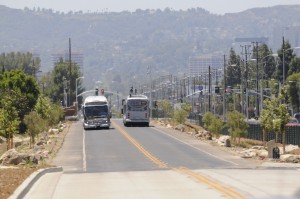Scott Wiener’s revolutionary SB 827 proposal to ease local restrictions on transit-oriented development is part of a growing legislative trend to tie development incentives to proximity to major transit stops. These stops are defined to include those with frequent bus service. As a result, some pro-growth advocates worry that NIMBYs will respond by lobbying their transit agencies to decrease bus service in their neighborhoods so developers can’t access these benefits and build more in their area.
But what about the opposite problem, where developers lobby transit agencies to increase bus service, merely to get some of the permit streamlining and density boosts that would follow? The danger is that transit agencies would comply, perhaps as a favor to a politically connected developer, but the project at issue wouldn’t actually be transit-oriented or otherwise justify the increased transit service.
 And a worse situation might involve the transit agency increasing bus service only temporarily to qualify the project for the land use and permitting benefits, and then later reduce the service. The consequence could be a type of “density sprawl” with projects that wouldn’t serve transit (or have transit serve them) and instead increase overall driving miles and pollution.
And a worse situation might involve the transit agency increasing bus service only temporarily to qualify the project for the land use and permitting benefits, and then later reduce the service. The consequence could be a type of “density sprawl” with projects that wouldn’t serve transit (or have transit serve them) and instead increase overall driving miles and pollution.
To be clear, we want to encourage development near major bus stops. And this policy trend of tying incentives to transit proximity started before SB 827. For example, SB 375 (Steinberg, 2008) provides permitting relief through streamlining provisions under the California Environmental Quality Act (CEQA) for projects within 1/2 mile of a major transit stop, including frequent bus stops. Similarly, SB 743 (Steinberg, 2013), also relaxes CEQA’s transportation impact analysis for projects in these areas.
But both possibilities of manipulating bus service either to 1) avoid new development in the right transit-oriented areas or 2) facilitate car-oriented projects in less transit-friendly areas would be bad.
What’s the solution? Transit agencies will need to develop strong and transparent standards governing their decisions about when to expand or retract major bus service (defined as 15 minute peak headways during commute times). Follow-up state legislation could potentially accomplish this outcome by mandating such standards on local transit agencies (something these transit agencies would probably hate). Or transit agencies that don’t already have such policies on the books could adopt such standards on their own, perhaps using some best practice examples from around the state and country.
Right now, I don’t think this kind of transit service manipulation is a serious problem, although I’ve started to hear some anecdotes from local transit agencies. But if SB 827 passes in anything like its current form, it may become an issue that policy makers at either the local or state levels will need to address.


